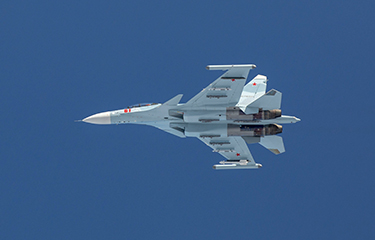US fishing fleet in Bering Sea rattled by Russian military exercises

The U.S. Coast Guard has vowed to ramp up notifications of Russian military exercises in the northern Bering Sea after U.S.-flagged fishing fleets were driven off fishing grounds there the end of August.
At-Sea Processors Association (APA) Executive Director Stephanie Madsen said U.S. boats were fishing for pollock in the Bering Sea’s U.S. exclusive economic zone (EEZ) when they were startled by the nearby activities of Russian warships, submarines, and aircraft.
In testimony prepared for a U.S. Senate subcommittee hearing on Arctic security, Madsen described harrowing episodes in which fishing boats from major processors like Trident Seafoods and American Seafoods were buzzed by Russian aircraft and warships and ordered to leave the grounds immediately, which they did, some even cutting their gear before rushing out of the area.
The main problem, Madsen told SeafoodSource, is that U.S. boats had no prior notice of the Russian military exercise, known as Ocean Shield.
“What was unprecedented in our minds is that we were never notified. The U.S. Department of Defense and the State Department said the Russians filled out the HYDROPAC notification properly, but there just seemed to be a disconnect between whoever gets that information and communicates it to the fishing fleet,” Madsen told SeafoodSource.
In her testimony to the Senate subcommittee, Madsen pointed out that U.S. pollock fleets fish within “literal shouting distance” of Russian vessels. The testimony said despite the proximity to a geopolitical adversary, fleets have coexisted "safely and with legal certainty" since the maritime boundary was set in 1990.
But that safety and certainty vanished on 25 August of this year, when crew onboard Trident Seafoods’ catcher-processor vessel Island Enterprise saw what they would later learn was a Russian nuclear submarine nearby, then warships.
“Warships appeared, traveling at 17.5 knots on direct course towards the submarine. The warship made no contact with the Island Enterprise, but came within 2.5 nautical miles” Madsen’s testimony reads, stating it was the first indication to the U.S. fishing fleet that there were Russian military exercises in the area.
The following day, 26 August, American Seafoods’ catcher-processor Northern Jaeger, operating 21 miles within the U.S. EEZ, was harassed by a Russian warplane, which delivered an "alarming drumbeat" of danger messages and requests to leave the area.
After hours of trying to clarify the nature of the situation, the Northern Jaeger did leave the area. Northern Jaeger skipper Tim Thomas would say later that the incident cost him five days of fishing time and hundreds of thousands of dollars.
“We lost fishing time, which no one is going to compensate us for. It’s been a tough B-season and we were on good fish. We lost time leaving the area and then were told by the Russian military to stay out of that area for a few days. There’s a cost to that,” Madsen told SeafoodSource.
The situation repeated itself with freezer longliners Bristol Leader and Blue North, the latter of which cut its gear after reporting warning flyovers by Russian planes as close as 200 feet above the vessel. Another pod of eight U.S. vessels operating 50 nautical miles within the U.S. EEZ also fled the area on Russia’s insistence.
“As a representative of the U.S. fishing industry – and indeed as a proud American citizen – I find it completely unacceptable that U.S.-flagged vessels operating lawfully within the U.S. EEZ could ever be subjected to this kind of treatment,” said Madsen, who has served as the APA director for 12 years.
In a brief released earlier this month, the U.S. Coast Guard said it was working with fishing industry officials and government bodies to ensure better communication about Russian military exercises.
The brief also stated that “ongoing discussions between the Coast Guard, the Coast Guard Attaché in Moscow, State Department liaisons, and Alaska Command are exploring [the] whole of government coordination mechanisms with the goal of an appropriate diplomatic response to the incident.”
The Coast Guard said Ocean Shield – which includes live-fire exercises, aircraft sorties, and amphibious landings – started in 2018 in the Mediterranean and was conducted in the Baltic Sea last year. It expanded into the Bering Sea and the Arctic this year as part of Russia’s Arctic strategy, which includes plans for 2035 to exploit natural resources in the Arctic by way of the Northern Sea Route.
“Are they flexing their muscles for the Arctic a little bit? Yes, I think they are. It’s a speculation and I don’t really know where to go with it, but we do think the Russians are positioning themselves to be dominant in the Arctic,” Madsen told SeafoodSource.
Pollock is among the world’s largest volume fisheries, and most of the world’s pollock, around 3 million tons annually, comes from the North Pacific. U.S. pollock fishermen catch on average 1.5 million tons annually, which according to the National Oceanic and Atmospheric Administration (NOAA) accounts for 30 percent of all fish caught in the U.S. by weight.
Photo courtesy of Vectorkel/Shutterstock






Share